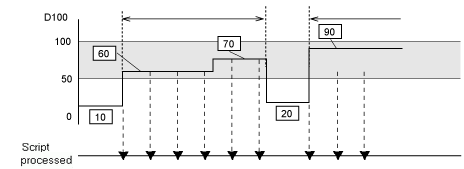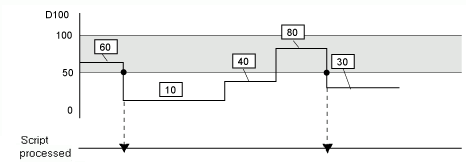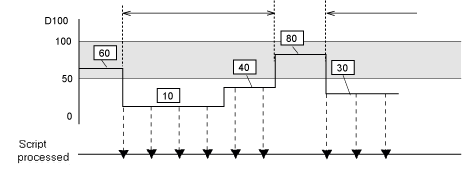![]()
The interval for the trigger bit ON/OFF status or true/false condition must be longer than the communication cycle time*1 or display scan time*2, whichever is longer. See the following for more details.
 21.10.5 Restrictions on the Triggered Bit
21.10.5 Restrictions on the Triggered Bit
A created script can use any of the following 11 types of trigger conditions.
![]()
The interval for the trigger bit ON/OFF status or true/false condition must be longer than the communication cycle time*1 or display scan time*2, whichever is longer. See the following for more details.![]() 21.10.5 Restrictions on the Triggered Bit
21.10.5 Restrictions on the Triggered Bit
Executes each display scan time.
Each time the designated time elapses, the script is executed one time. The timer duration can be set from 1 to 32767 seconds.

![]()
When setting the timer function's time, the time value includes the set time + display scan time error. Also, depending on the time taken to draw a screen item or to print out data, the timer function may be slowed.
When using D-Script, switching the screen causes the timer function to restart counting from 0.
When the display unit detects the designated bit address (trigger bit) rise from 0 to 1, the script is triggered.

While the designated bit address (trigger bit) is ON, the script is executed at every display scan time.

When the GP detects the designated bit address (trigger bit) fall from 1 to 0, the script is triggered.

While the designated bit address (trigger bit) is OFF, the script is executed at every display scan time.

When the GP detects the designated bit address (trigger bit) rise from 0 to 1 or fall from 1 to 0, the script is triggered.

When the display unit evaluates the trigger condition as true, the script runs one time.
When the Triggered Condition is set to 100 > [D100] > 50, the script will execute with the following timing.
[False] → [True] is detected, the script executes and 70 is assigned to D100.
The script does not run when [True] → [True] is detected.

While the condition specified in Trigger Condition Expression is true, the script is executed at every display scan time.
When the Triggered Condition is set to 100 > [D100] > 50, the script will execute with the following timing.

When the display unit evaluates the trigger condition as false, the script runs one time.
When the Triggered Condition is set to 100 > [D100] > 50, the script will execute with the following timing.
[True] → [False] is detected, the script executes and 20 is assigned to D100.
The script does not run when [False] → [False] is detected.

While the condition specified in Trigger Condition Expression is false, the script is executed at every display scan time.
When the Triggered Condition is set to 100 > [D100] > 50, the script will execute with the following timing.

*1 The Communication Cycle Time is the time from when the display unit requests data from the device/PLC, until the display unit receives the data. It is stored in internal device LS2037 in Bin format. The unit is 10 milliseconds. There is an error of +/-10 milliseconds.
When using multiple devices/PLCs, you can check each communication cycle time from the [System Settings] window's [Display] page, in the [List of Device/PLC Management Addresses] area.![]() 5.19.13 Peripheral List Settings Guide
5.19.13 Peripheral List Settings Guide
*2 Display Scan Time is the time required to process one screen. It is stored in internal device LS2036 in Bin format. The unit is in milliseconds. There is an error of +/-10 milliseconds.